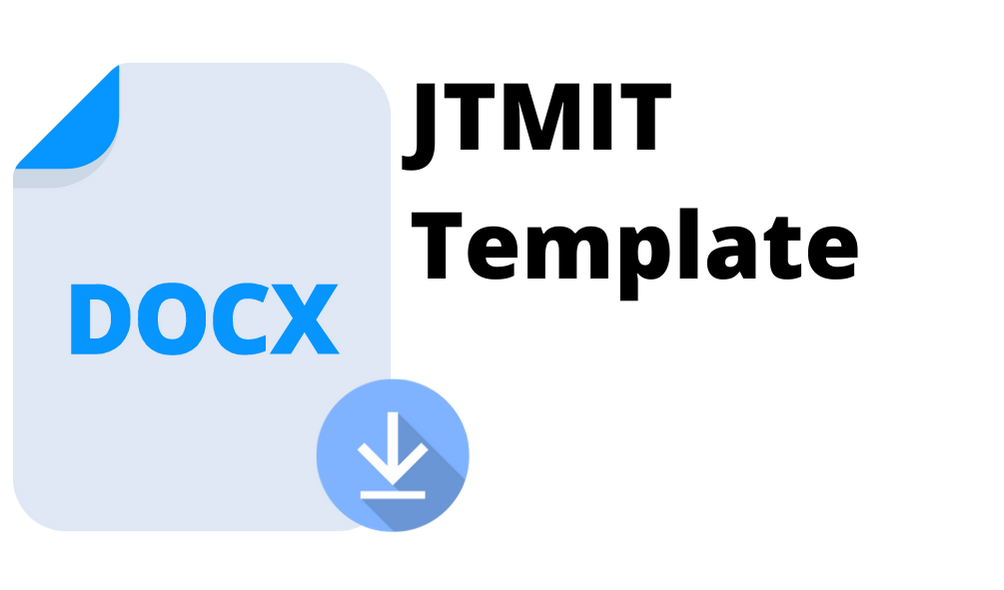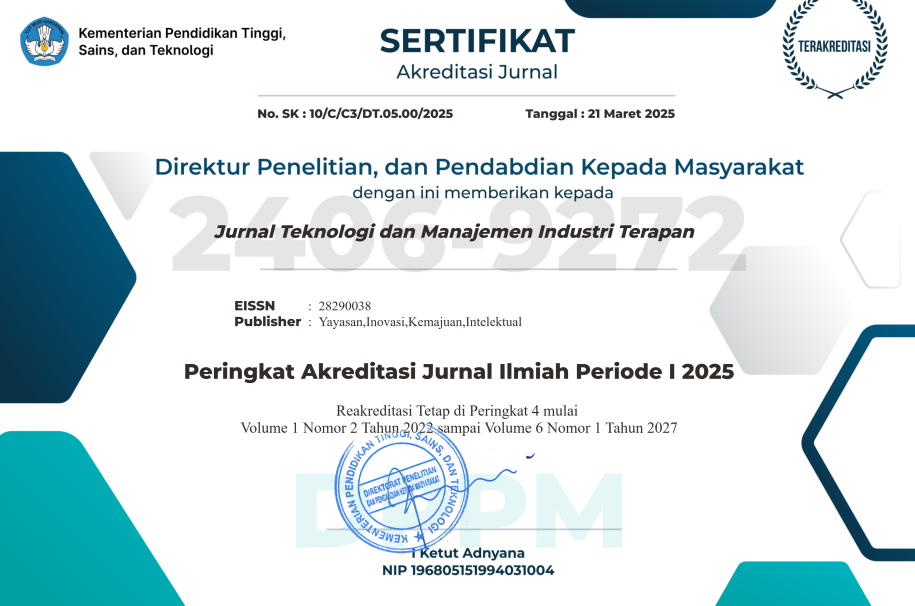Review Penggunaan Metode Pengendalian Kualitas pada Proses Manufaktur Kapal
DOI:
https://doi.org/10.55826/tmit.v2i4.284Keywords:
Shipbuilding, Ships, Manufacturing, QualityAbstract
Pembuatan kapal adalah proses manufaktur multi-tahap dengan berbagai sumber yang khas dengan fungsi kompleks dan membutuhkan kualitas konstruksi yang tinggi. Beberapa hal penting dalam pengendalian kualitas pembuatan kapal seperti perencanaan pada desain kapal, material yang digunakan, dan metode pengendalian kualitas. Era globalisasi menuntut industri galangan kapal terus meningkatkan efektivitas dan efisiensi pada proses produksinya, sehingga mampu bersaing dari segi quality, cost dan on time delivery (QCD). Tujuan dari penelitian ini yaitu untuk mengetahui berbagai metode pengendalian kualitas pada proses manufaktur kapal diberbagai negara di dunia. Penelitian ini menggunakan metode sistematik kajian literatur dari berbagai artikel yang telah terbit yang kemudian diidentifikasi dan di analisis yang berfokus pada berbagai metode pengendalian kualitas pada proses manufaktur kapal. Beberapa metode diperoleh berdasarkan hasil pencarian, diantaranya adalah function-oriented quality control (FOQC), quantitative evaluation method, artificial intelligence, toyota production system (TPS), tacheometer sensors, design point generation method, dimensional & accuracy control automation, a differentiation-based approach, computer-based applications, statistical process control (SPC), inspection test plan (ITP), multi-layer quality function deployment (QFD). Industri perkapalan akan terus menghadapi berbagai tantangan di masa depan, termasuk persaingan global yang semakin ketat, tuntutan untuk meningkatkan efisiensi dan produktivitas, serta perubahan teknologi.
References
Fitriadi et al., “Identification of waste for shipyard through lean manufacturing approach,” AIP Conf. Proc., vol. 2484, no. 1, Mar. 2023, doi: 10.1063/5.0110526/2879703.
M. Riyadi, D. Manfaat, and B. Ma’ruf, “Kajian Efesiensi Proses Produksi Kapal dengan Pendekatan Konsep Manufacturing Cycle Effectiveness (MCE) Studi Kasus PT. PAL,” Wave J. Ilm. Teknol. Marit., vol. 9, no. 2, pp. 57–64, Jan. 2015, doi: 10.29122/Jurnalwave.V9I2.2658.
H. Wang, Y. Guo, X. Liang, and H. Yi, “A function-oriented quality control method for shipbuilding,” Ships Offshore Struct., vol. 14, no. 2, pp. 220–228, Feb. 2019, doi: 10.1080/17445302.2018.1493910.
H. Moyst and B. Das, “Factors Affecting Ship Design and Construction Lead Time and Cost,” J. Sh. Prod., vol. 21, no. 03, pp. 186–194, Aug. 2005, doi: 10.5957/JSP.2005.21.3.186.
E. Lee, J. G. Shin, and Y. Park, “A Statistical Analysis of Engineering Project Risks in the Korean Shipbuilding Industry,” J. Sh. Prod., vol. 23, no. 04, pp. 223–230, Nov. 2007, doi: 10.5957/JSP.2007.23.4.223.
A. Saputra, F. Fitriadi, I. Pamungkas, K. Hadi, and M. Muzakir, “Penerapan Lean Manufacturing di CV. Wahana Karya,” J. Pengabdi. Agro Mar. Ind., vol. 1, no. 2, pp. 20–25, Nov. 2021, Accessed: Nov. 19, 2023. [Online]. Available: http://jurnal.utu.ac.id/agromarine/article/view/4402
H. T. Irawan et al., “Perancangan Ulang Tata Letak pada Galangan Kapal Tradisional menggunakan Blocplan-90,” J. Optim., vol. 9, no. 2, pp. 148–156, Oct. 2023, doi: 10.35308/JOPT.V9I2.8325.
Muzakir et al., “Defect analysis to improve quality of traditional shipbuilding processes in West Aceh District, Indonesia,” AIP Conf. Proc., vol. 2484, no. 1, Mar. 2023, doi: 10.1063/5.0111429/2879560.
E. Prayetno et al., “Analisis Quality Control Di Galangan Kapal Tradisional,” J. Sustain. J. Has. Penelit. dan Ind. Terap., vol. 5, no. 2, pp. 1–5, Oct. 2016, doi: 10.31629/SUSTAINABLE.V5I2.366.
M. H. Spicknall and R. Kumar, “A Dimensional Engineering Process For Shipbuilding.,” J. Sh. Prod., May 2002.
I. Pamungkas, H. T. Irawan, and L. Arkanullah, “Implementasi Statistical Process Control Untuk Pengendalian Kualitas Garam Tradisional Di Kabupaten Pidie,” J. Optim., vol. 4, no. 2, pp. 108–118, Jan. 2020, doi: 10.35308/JOPT.V4I2.1525.
I. Setiawan and H. H. Purba, “A Systematic Literature Review of Key Performance Indicators (KPIs) Implementation,” J. Ind. Eng. Manag. Res., vol. 1, no. 3, pp. 200–208, Oct. 2020, doi: 10.7777/JIEMAR.V1I3.79.
H. Kurnia, “A Systematic Literature Review of Performance Pyramids System Implementation in the Manufacture Industries,” IJIEM (Indonesian J. Ind. Eng. Manag., vol. 2, no. 2, pp. 115–126, 2021, doi: 10.22441/ijiem.v2i2.11150.
I. Pamungkas, H. T. Irawan, and H. Hasnita, “Penggunaan Teknik Evaluasi Keandalan Mesin Pada Berbagai Industri di Indonesia: Literature Review,” VOCATECH Vocat. Educ. Technol. J., vol. 5, no. 1, pp. 22–32, Sep. 2023, doi: 10.38038/VOCATECH.V5I1.128.
I. Pamungkas et al., “Metode Analisis Risiko Kerusakan Mesin Produksi di Indonesia: Literature Review,” J. INVASI Ind. dan Inov., vol. 1, no. 1, pp. 01–11, Sep. 2023, Accessed: Nov. 19, 2023. [Online]. Available: http://jurnal.utu.ac.id/invasi/article/view/8090
Y. Guo, H. Wang, X. Liang, and H. Yi, “A quantitative evaluation method for the effect of construction process on shipbuilding quality,” Ocean Eng., vol. 169, pp. 484–491, Dec. 2018, doi: 10.1016/J.OCEANENG.2018.09.046.
V. Emelianov, A. Zhilenkov, S. Chernyi, A. Zinchenko, and E. Zinchenko, “Application of artificial intelligence technologies in metallographic analysis for quality assessment in the shipbuilding industry,” Heliyon, vol. 8, no. 8, p. e10002, Aug. 2022, doi: 10.1016/J.HELIYON.2022.E10002.
D. Alves De Moura and R. Carlos Botter, “Independent Journal of Management & Production Toyota Production System-One Example To Shipbuilding Industry,” Indep. J. Manag. Prod., vol. 8, pp. 874–897, 2017, doi: 10.14807/ijmp.v8i3.626.
“Nguyen Trung Anh, V. N. Lubenko, ‘Use of tacheometer sensors in quality control systems in shipbuilding’, Vestn. Astrakhan State Technical Univ. Ser. Management, Computer Sciences and Informatics, 2014, no. 2, 52–57.” https://www.mathnet.ru/php/archive.phtml?wshow=paper&jrnid=vagtu&paperid=314&option_lang=eng (accessed Nov. 19, 2023).
K. Y. Kwon, “Design Point Generation Method from a Lightweight Model for Dimensional Quality Management in Shipbuilding,” J. Sh. Prod. Des., vol. 35, no. 04, pp. 353–363, Nov. 2019, doi: 10.5957/JSPD.08170042.
G. W. Johnson, S. E. Laskey, S. Robson, and M. R. Shortis, “DImensional & Accuracy Control Automation In Shipbuilding Fabrication: An Integration Of Advanced Image Interpretation, Analysis, And Visualization Techniques”.
T. Bukša, D. Pavletić, M. Soković, and J. Bukša, “A Differentiation-Based Approach to Quality Management in Shipbuilding Taking into Consideration Errors in Manufacturing Processes,” Brodogr. An Int. J. Nav. Archit. Ocean Eng. Res. Dev., vol. 64, no. 4, pp. 488–503, Dec. 2013.
R. R. P, T. W.P., and M. S. Arif, “Computer-Based Applications for Quality Management Process in Shipbuilding,” IPTEK J. Proc. Ser., vol. 3, no. 2, pp. 99–107, May 2017, doi: 10.12962/J23546026.Y2017I2.2305.
M. R. KATTAN, “Application Of Statistical Process Control Techniques To Shipbuilding,” North East Coast Inst. Eng. Shipbuild. Trans., vol. 105, no. No.4, Sep. 1989.
I. D. Savu, S. V. Savu, and M. G. Ghiba, “New Concept of Quality Management in Shipbuilding,” Adv. Eng. Forum, vol. 13, pp. 332–340, Jun. 2015, doi: 10.4028/WWW.SCIENTIFIC.NET/AEF.13.332.
O. Duru, S. T. Huang, E. Bulut, and S. Yoshida, “Multi-layer quality function deployment (QFD) approach for improving the compromised quality satisfaction under the agency problem: A 3D QFD design for the asset selection problem in the shipping industry,” Qual. Quant., vol. 47, no. 4, pp. 2259–2280, Jun. 2013, doi: 10.1007/S11135-011-9653-4/METRICS.
Y. J. Song and J. H. Woo, “New shipyard layout design for the preliminary phase & case study for the green field project,” Int. J. Nav. Archit. Ocean Eng., vol. 5, no. 1, pp. 132–146, Mar. 2013, doi: 10.2478/IJNAOE-2013-0122.
Downloads
Published
Issue
Section
License
Copyright (c) 2023 Iing Pamungkas, Heri Tri Irawan, Khairul Hadi, Arhami

This work is licensed under a Creative Commons Attribution-NonCommercial-ShareAlike 4.0 International License.


















